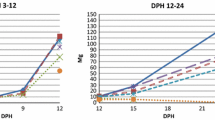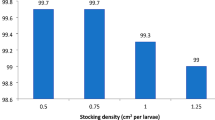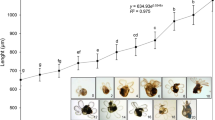Abstract
The effects of weaning strategies of cobia (Rachycentron canadum L.) larvae to commercial microdiets, either from rotifers or from Artemia, on growth, survival and enzymatic digestive capacity, were investigated. In the first experiment, cobia larvae were weaned from rotifers by co-feeding with a microdiet (Otohime) from 8, 13 or 20 days post-hatching (dph). The larvae in the control treatment were fed rotifers (2–12 dph), Artemia nauplii from 7 dph, and co-fed with the microdiet from 20 dph. In the second experiment, the larvae were weaned from Artemia, which was fed to the larvae from 7 dph, by co-feeding with a microdiet (NRD) from 8, 13 or 18 dph. The larvae in control treatment were fed rotifers, then Artemia to the end of the experiment (28 dph). Weaning of cobia larvae onto a microdiet directly from rotifers significantly reduced growth, survival and digestive capacity of the larvae and did not lead to larval acceptance of the microdiet, compared to those weaned from Artemia in the first experiment. Early weaning of cobia larvae onto NRD microdiet (on 8 or 13 dph) from Artemia in the second experiment also reduced growth, survival rate and gut maturation index, compared to those fed live feed. With available microdiets, weaning of cobia larvae could start from Artemia at around 18 dph in order to obtain comparable growth, survival and gut maturation to larvae fed live feed.



Similar content being viewed by others
Abbreviations
- AF:
-
Artemia franciscana
- AP:
-
Alkaline phosphatase
- ARA:
-
Arachidonic acid
- bbm:
-
Brush border membrane
- DHA:
-
Docosahexaenoic acid
- dph:
-
Days post-hatch
- EG:
-
Great Salt Lake Artemia
- EPA:
-
Eicosapentaenoic acid
- HUFA:
-
Highly unsaturated fatty acids
- LF:
-
Live feed
- LAP:
-
Leucine aminopeptidase
- leu-ala:
-
Leucine-alanine peptidase
- OTH:
-
Otohime
- SL:
-
Standard length
- RIA1:
-
Research Institute for Aquaculture No.1
References
Baskerville-Bridges B, Kling LJ (2000) Early weaning of Atlantic cod (Gadus morhua) larvae onto a microparticulate diet. Aquaculture 189:109–117
Benetti DD, Sardenberg B, Welch A, Hoenig R, Orhun MR, Zink I (2008) Intensive larval husbandry and fingerling production of cobia Rachycentron canadum. Aquaculture 281:22–27
Bessey OA, Lowry OH, Brock MJ (1946) Rapid coloric method for determination of alkaline phosphatase in five cubic millimetres of serum. J Bio Chem 164:321–329
Bligh EG, Dyer WJ (1959) A rapid method of total lipid extraction and purification. Can J Biochem Physiol 37:911–917
Bradford MM (1976) A rapid and sensitive method for quantification of microgram quantity of protein utilizing the principle of protein-dye binding. Anal Biochem 72:248–254
Cahu CL, Zambonino Infante JL (1994) Early weaning of sea bass (Dicentrarchus labrax) larvae with a compound diet: effective on digestive enzymes. Comp Biochem Physiol 109A:213–222
Cahu CL, Zambonino Infante JL (1995) Effect of the molecular form of dietary nitrogen supply in sea bass larvae–response of pancreatic enzymes and intestinal peptidases. Fish Physiol Biochem 14:209–214
Cahu CL, Zambonino Infante JL (1997) Is the digestive capacity of marine fish larvae sufficient for compound diet feeding? Aquacult Int 5:151–160
Cahu CL, Zambonino Infante JL (2001) Substitution of live food by formulated diets in marine fish larvae. Aquaculture 200:161–180
Cahu CL, Zambonino Infante JL, Quazuguel P, Le Gall MM (1999) Protein hydrolysate vs, fish meal in compound diets for 10-day old sea bass Dicentrarchus labrax larvae. Aquaculture 171:109–119
Cahu CL, Zambonino Infante JL, Barbosa V (2003) Effect of dietary phospholipid level and phospholipid : neutral lipid value on the development of sea bass (Dicentrarchus labrax) larvae fed a compound diet. Br J Nutr 90:21–28
Civera-Cerecedo R, Alvarez-Gonzalez CA, Garcia-Gomez RE, Carrasco-Chavez V, Ortiz-Galindo JL, Rosales-Velazquez MO, Alamo TG, Moyano-Lopez FJ (2008) Effect of microparticulate diets on growth and survival of spotted sand bass larvae, Paralabrax maculatofasciatus, at two early weaning times. J World Aquac Soc 39:22–36
Crane RK, Boge G, Rigal A (1979) Isolation of brush border membranes in vesicular form from intestinal spiral valve of small dogfish (Scyliorhinus canicula). Biochim Biophys Acta 554:264–267
Curnow J, King J, Bosmans J, Kolkovski S (2006a) The effect of reduced Artemia and rotifers use facilitated by a new microdiet in the rearing of barramundi Lates calcarifer (BLOCH) larvae. Aquaculture 257:204–213
Curnow J, King J, Partridge G, Kolkovski S (2006b) Effects of two commercial microdiets on growth and survival of barramundi (Lates calcarifer Bloch) larvae within various early weaning protocols. Aquac Nutr 12:247–255
Engrola S, Conceicao LEC, Dias L, Pereira R, Ribeiro L, Dinis MT (2007) Improving weaning strategies for Senegalese sole: effects of body weight and digestive capacity. Aquacult Res 38:696–707
Evjemo JO, Danielsen TL, Olsen Y (2001) Losses of lipid, protein and n-3 fatty acids in enriched Artemia franciscana starved at different temperatures. Aquaculture 193:65–80
Faulk CK, Benninghoffz AD, Holt GJ (2007a) Ontogeny of gastrointestinal tract and selected digestive enzymes in cobia Rachycentron canadum (L.). J Fish Biol 70:567–583
Faulk CK, Kaiser JB, Holt GJ (2007b) Growth and survival of larval and juvenile cobia Rachycentron canadum in a recirculating raceway system. Aquaculture 270:149–157
Fernandez-Diaz C, Yufera M (1997) Detecting growth in gilthead seabream, Sparus aurata L, larvae fed microcapsules. Aquaculture 153:93–102
Hamza N, Mhetli M, Ben Khemis I, Cahu C, Kestemont P (2008) Effect of dietary phospholipid levels on performance, enzyme activities and fatty acid composition of pikeperch (Sander lucioperca) larvae. Aquaculture 275:274–282
Hitzfelder GM, Holt GJ, Fox JM, McKee DA (2006) The effect of rearing density on growth and survival of Cobia, Rachycentron canadum, larvae in a closed recirculating aquaculture system. J World Aquac Soc 37:204–209
Holm H, Hanssen LE, Krogdahl A, Florholmen J (1988) High and low inhibitor soybean meals affect human duodenal proteinase activity differently: in vivo comparison with bovine serum albumin. J Nutr 118:515–520
Holt GJ (1993) Feeding larval red drum on microparticulate diets in a closed recirculating water system. J Aquac Soc 24:225–230
Holt GJ, Faulk CK, Schwarz MH (2007) A review of the larviculture of cobia Rachycentron canadum, a warm water marine fish. Aquaculture 268:181–187
Kirsten WJ (1979) Automatic methods for the simultaneous determination of carbon, hydrogen, nitrogen, and sulfur, and for sulfur alone in organic and inorganic materials. Anal Chem 51:1173–1179
Kolkovski S (2001) Digestive enzymes in fish larvae and juveniles–implications and applications to formulated diets. Aquaculture 200:181–201
Lavens P, Sorgeloos P (1996) Manual on the production and use of live food for aquaculture. FAO Fisheries Technical Paper No. 361. 295 pp
Lazo JP, Holt GJ, Arnold CR (2000a) Ontogeny of pancreatic enzymes in larval red drum Sciaenops ocellatus. Aquac Nutr 6:183–192
Lazo JP, Dinis MT, Holt GJ, Faulk C, Arnold CR (2000b) Co-feeding microparticulate diets with algae: toward eliminating the need of zooplankton at first feeding in larval red drum (Sciaenops ocellatus). Aquaculture 188:339–351
Le Ruyet JP, Alexandre JC, Thebau L, Mugier C (1993) Marine fish larvae feeding: formulated diets or live preys? J World Aquac Soc 24:211–224
Liao IC (2003) Candidate species for open ocean aquaculture: the successful case of cobia Rachycentron canadum in Taiwan. In: Bridger CJ, Costa-Pierce BA (eds) Open ocean aquaculture: from research to commercial reality. The World Aquaculture Society, Baton Rouge, pp 205–213
Liao IC, Huang T-S, Tsai W-S, Hsueh CM, Chang S-L, Leaño EM (2004) Cobia culture in Taiwan: current status and problems. Aquaculture 237:155–165
Ma H, Cahu CL, Zambonino Infante JL, Yu H, Duan Q, Le Gall MM, Mai K (2005) Activities of selected digestive enzymes during larval development of large yellow croaker (Pseudociaena crocea). Aquaculture 245:239–248
Maroux S, Louvard D, Baratti J (1973) Aminopeptidase from hog intestinal brush border. Biochim Biophys Acta 321:282–295
Metcalfe LD, Schimtz AA, Pelka JR (1966) Rapid preparation of fatty acid esters from lipids for gas chromatography. Analyt Chem 38:514–515
Nguyen QH, Sveier H, Bui VH, Le AT, Nhu VC, Tran MT, Svennevig N (2008) Growth performance of cobia, Rachycentron canadum, in sea cages using extruded fish feed or trash fish. In: Yang Y, Vu XZ, Zhou YQ (eds) Cage aquaculture in Asia: proceedings of the second international symposium on cage aquaculture in Asia. Asian Fishery Society/Zhejang University, Manila/China, pp 42–47
Nguyen QH, Reinertsen H, Tran MT, Kjørsvik E (2009) Ontogeny and characterization of some intestinal enzymes in cobia (Rachycentron canadum) larvae. In: Hendry CI, Van Stappen G, Wille M, Sorgeloos P (eds) LARVI 09- FISH AND SHELLFISH LARVICULTURE SYMPOSIUM. European Aquaculture Society, Belgium, pp 295–296 Special Publication No. 38
Nicholson JA, Kim YS (1975) A one-step L-amino acid oxidase assay for intestinal peptide hydrolase activity. Anal Biochem 63:110–117
Olsen Y (2004) Live food technology of cold water marine fish larvae. In: Moksness E, Kjørsvik E, Olsen Y (eds) Culture of cold-water marine fish. Blackwell publishing, Oxford, pp 73–128
Rainuzzo JR, Reitan KI, Jorgensen L (1992) Comparative study on the fatty-acid and lipid composition of 4 marine fish larvae. Comp Biochem Physiol 103:21–26
Ribeiro L, Zambonino Infante JL, Cahu C, Dinis MT (2002) Digestive enzymes profile of Solea senegalensis post larvae fed Artemia and a compound diet. Fish Physiol Biochem 27:61–69
Rosenlund G, Halldorsson O (2007) Cod juvenile production: research and commercial developments. Aquaculture 268:188–194
Rosenlund G, Meslo I, Rodsjo R, Torp H (1993) Large scale production of cod. In Reinertsen H, Dahle LA, Jorgensen L, Tvinnereim K (eds.), Proceedings of the First International Conference on Fish Farming Technology, Trondheim, Norway, 9–12 August. Balkema, Rotterdam. pp 141–146
Sorgeloos P, Dhert P, Candreva P (2001) Use of the brine shrimp, Artemia spp., in marine fish larviculture. Aquaculture 200:147–159
Walne P (1966) Experiments in the large-scale culture of larvae of Ostrea edulis L. Fish Invest Serie II 25(4):1–53
Watanabe T, Kiron V (1994) Prospects in larval fish dietetics. Aquaculture 124:223–251
Wold PA, Hoehne-Reitan K, Cahu CL, Zambonino Infante JZ, Rainuzzo J, Kjørsvik E (2007) Phospholipids vs. neutral lipids: effects on digestive enzymes in Atlantic cod (Gadus morhua) larvae. Aquaculture 272:502–513
Xan L (2005) Advances in seed production of cobia Rachycentron canadum in Vietnam. Aquaculture Asia 10:21–22
Zouiten D, Ben Khemis I, Besbes R, Cahu C (2008) Ontogeny of the digestive tract of thick lipped grey mullet (Chelon labrosus) larvae reared in “mesocosms”. Aquaculture 279:166–172
Acknowledgments
We sincerely thank the project “Building Advanced Research, Education and Extension Capacity for RIA-1” (Project No. SRV0033) co-funded by Norwegian and Vietnamese Governments for financial support to this study. The authors also thank the Quota Scheme at Norwegian University of Science and Technology (NTNU) for Nguyen Quang Huy’s PhD scholarship. We thank T. Bardal and at Department of Biology (NTNU) for excellent technical guidance with enzyme analyses, and colleagues at Research Institute for Aquaculture No.1 (RIA1) in Cua Lo for enthusiastic participation in the experiments of this study. The experiments were conducted under the Norwegian “Animal Protection Law”.
Author information
Authors and Affiliations
Corresponding author
Rights and permissions
About this article
Cite this article
Nguyen, H.Q., Reinertsen, H., Wold, PA. et al. Effects of early weaning strategies on growth, survival and digestive enzyme activities in cobia (Rachycentron canadum L.) larvae. Aquacult Int 19, 63–78 (2011). https://doi.org/10.1007/s10499-010-9341-8
Received:
Accepted:
Published:
Issue Date:
DOI: https://doi.org/10.1007/s10499-010-9341-8




